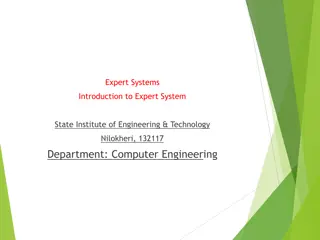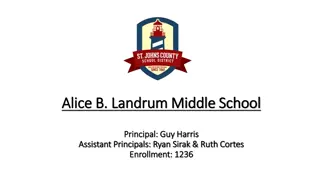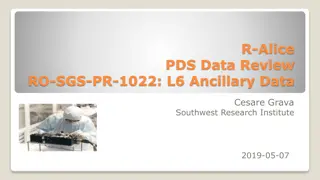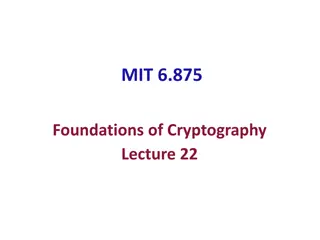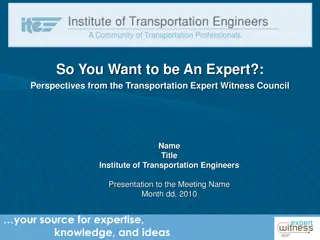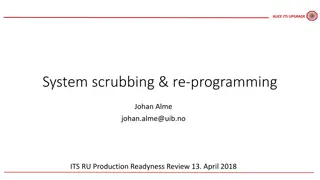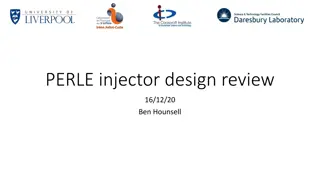
ALICE Expert System for Physics Data Analysis
Explore the ALICE Expert System used in the study of quark-gluon plasma physics at the ALICE Large Ion Collider Experiment. This system aims to assist shifters with diagnosing issues, making recommendations, and improving operational efficiency. Learn about knowledge representation, reasoning, and forward chaining techniques implemented in this expert system.
Download Presentation

Please find below an Image/Link to download the presentation.
The content on the website is provided AS IS for your information and personal use only. It may not be sold, licensed, or shared on other websites without obtaining consent from the author. If you encounter any issues during the download, it is possible that the publisher has removed the file from their server.
You are allowed to download the files provided on this website for personal or commercial use, subject to the condition that they are used lawfully. All files are the property of their respective owners.
The content on the website is provided AS IS for your information and personal use only. It may not be sold, licensed, or shared on other websites without obtaining consent from the author.
E N D
Presentation Transcript
ALICE Expert System Costin Ionita, CERN for the ALICE DAQ collaboration ACAT 2013, Beijing, May 16th 21st, 2013
Introduction ALICE A Large Ion Collider Experiment Study the physics of quark-gluon plasma using heavy-ion collisions Comprises a set of 18 detectors that measure different aspects of a collision e.g. number of resulting particles, trajectories, radiation emitted etc Operations are controlled using an experiment control system (ECS) receives status information from the online systems sends commands to them through interfaces based on Finite State Machines (FSM). 2 16-May-13 Costin Ionita, ACAT 2013 Beijing
The need for expert knowledge Shifters are not expert users of the system When they cannot solve the problem, shifters reach for the on-call expert Not all problems require advanced expert knowledge Some issues can be diagnosed and solved just by inspecting the state of certain sub-systems 3 16-May-13 Costin Ionita, ACAT 2013 Beijing
ALICE expert system Goals Assist human shifters in the ALICE control room Diagnose potential issues Make smart recommendations for troubleshooting Improve the efficiency of shifters with limited expertise Reduce the number of interventions of on-call people 4 16-May-13 Costin Ionita, ACAT 2013 Beijing
A generic expert system 5 16-May-13 Costin Ionita, ACAT 2013 Beijing
Knowledge representation and reasoning Facts & rules Facts - logic predicates that describe a given object running(a) indicates detector a is running Rules - Horn clauses that are used to reason whether a goal/action can be satisfied rc_servers_available([H|T]) :- check_running(H), check_not_locked(H),!, rc_servers_available(T). 6 16-May-13 Costin Ionita, ACAT 2013 Beijing
Knowledge representation and reasoning Forward chaining Given some facts, work forward through inference net Discovers what conclusions can be derived from data 7 16-May-13 Costin Ionita, ACAT 2013 Beijing
Knowledge representation and reasoning Backward chaining Work backwards looking for justifications for the decision Eventually, each decision must be justified by facts 8 16-May-13 Costin Ionita, ACAT 2013 Beijing
Knowledge representation and reasoning Forward vs backward chaining Forward chaining process not directed towards a goal disadvantage: cannot establish the reasons why a goal could not be satisfied Backward chaining backtrack whenever a predicate cannot be satisfied use this feature to store all reasons for which a certain action could not be performed Choose Prolog as an inference engine 9 16-May-13 Costin Ionita, ACAT 2013 Beijing
Knowledge representation and reasoning Storing failure reasons Prolog cannot deal natively with the root causes for a failure Work-around solution using its built-in backtracking mechanism check_granted(X) :- granted(X); failures(F), append(F,[X,'not granted'],F2), % append new failure retractall(failures(_)), assert(failures(F2)), fail. % assert new list and return % if true, continue % get the list of current failures % remove old list 10 16-May-13 Costin Ionita, ACAT 2013 Beijing
Architecture 11 16-May-13 Costin Ionita, ACAT 2013 Beijing
Diagnosis A priori detection Split the problem in smaller chunks that can be analyzed independently Attempt to recursively solve each problem until the most specific diagnose is found Limitation: not all problems can be detected a priori Runtime analysis is also needed, for instance to detect processes that have crashed during the run and need to be restarted 12 16-May-13 Costin Ionita, ACAT 2013 Beijing
Diagnosis Run-time failures Use the information stored by the logging system Identify frequently occurring faults and, using expert knowledge, define rules to handle them Unlike a priori diagnosis, run-time analysis is not real- time wait until the events have been stored in the database however, no action can be performed before a run stops anyway 13 16-May-13 Costin Ionita, ACAT 2013 Beijing
Use cases Recursive diagnosis Check specific actions Check whether a run can start Check why the previous run failed 14 16-May-13 Costin Ionita, ACAT 2013 Beijing
Use cases ECS vs Expert system 15 16-May-13 Costin Ionita, ACAT 2013 Beijing
Future work Instead of being just an assistant, allow the system to perform actions on behalf of users e.g. run scripts, send email alerts etc Improve user experience Integrate the expert system GUI within the ECS Revamp the GUI using more modern technologies 16 16-May-13 Costin Ionita, ACAT 2013 Beijing
17 16-May-13 Costin Ionita, ACAT 2013 Beijing



